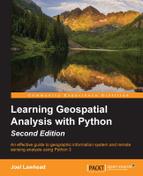This chapter covered the critical components of GIS analysis. You examined the challenges of measuring on the curved surface of the Earth using different approaches. You looked at the basics of coordinate conversion and full reprojection using OGR, the utm module with PyShp, and Fiona which simplifies OGR. We edited shapefiles and performed spatial and attribute selections. We created thematic maps from scratch using only Python. We imported data from spreadsheets. We parsed GPS data from NMEA streams. And we used geocoding to convert street addresses to locations and back.
As a geospatial analyst, you may be familiar with both GIS and remote sensing, but most analysts specialize in one field or the other. That is why, this book approaches the fields in separate chapters in order to focus on their differences. In Chapter 6, Python and Remote Sensing, we'll tackle remote sensing. In GIS, we have been able to explore the field using pure Python modules. In remote sensing, we'll become more dependent on bindings to compiled modules written in C due to the sheer size and complexity of the data.
